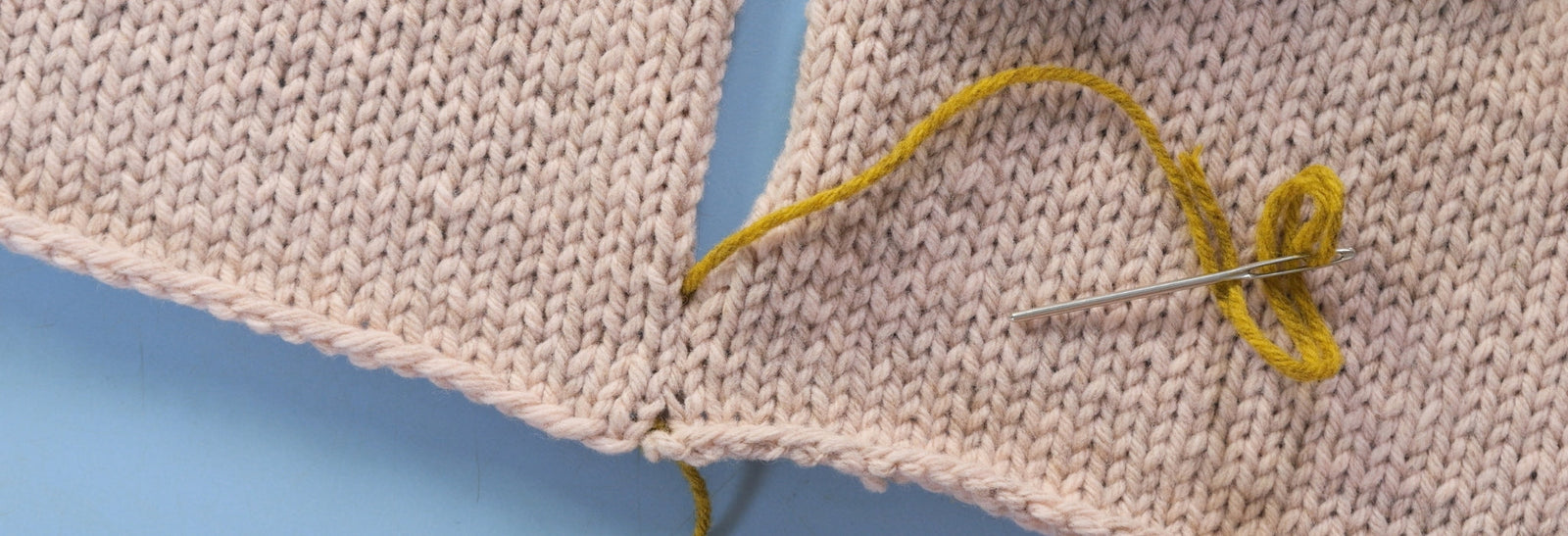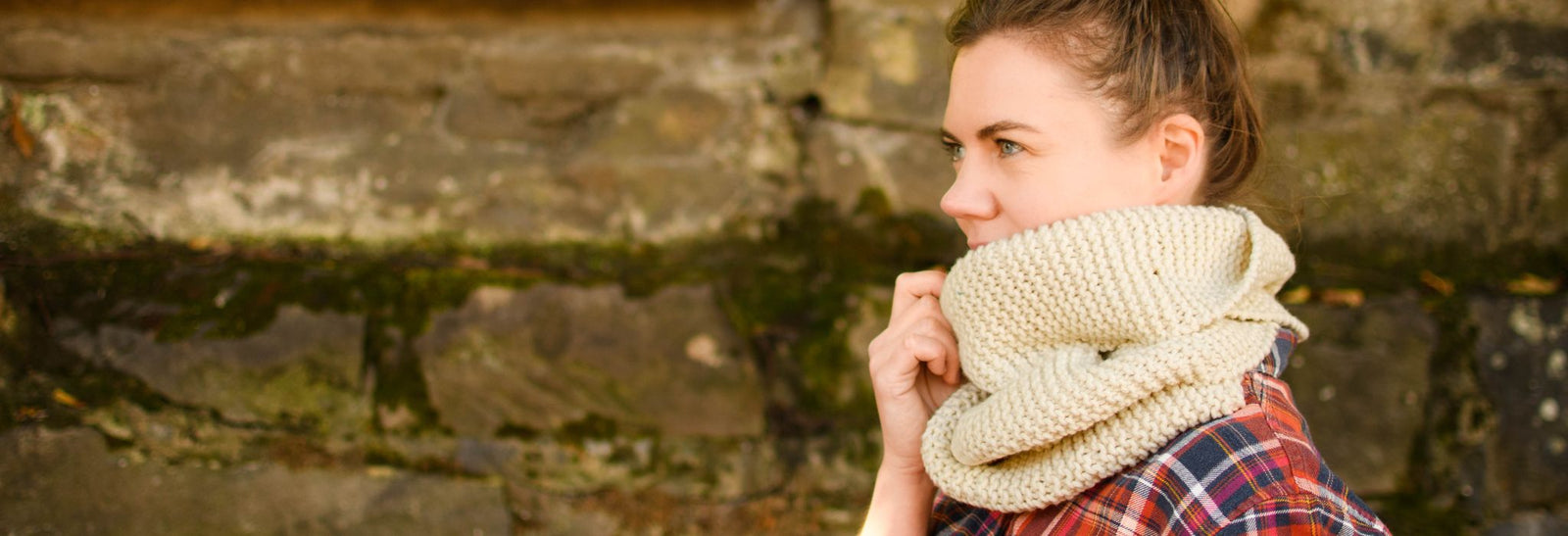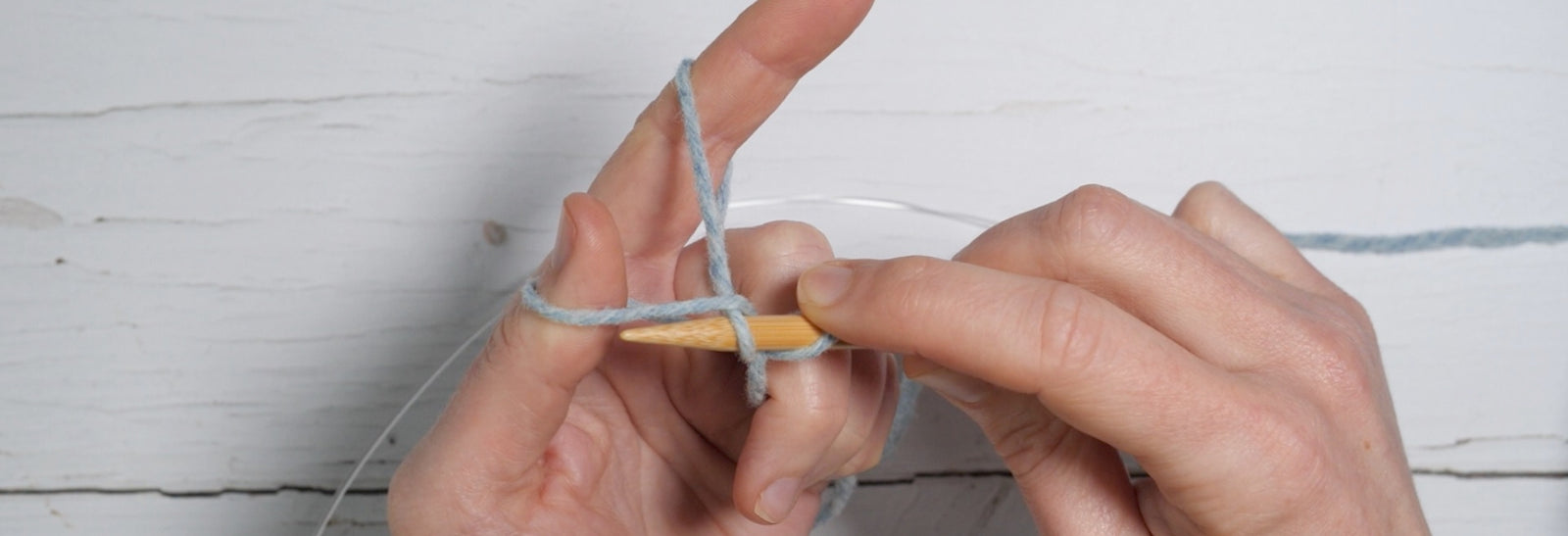Your Cart is Empty

How to work a sewn tubular bind-off
October 14, 2021
The sewn tubular bind-off is a beautiful way to finish the ribbing on toe-up socks, top-down hats and ribbed sweater neckbands. Although it's worked differently the end result is a perfect match for a tubular cast-on. Just like the cast-on the tubular bind-off is stretchy, polished and gives the effect of ribbing running seamless around the edge of your piece.
It's the perfect bind-off method for 1x1 rib, and can also be used for 2x2 rib and to finish brioche stitch projects.
The tubular bind-off begins with set-up rows worked in double knitting, which separates the knit and purl stitches into two layers. These layers are then grafted together to complete the bind-off.
You will need
Blunt darning needle
Spare needle(s) in the same size or a slightly smaller size than the working needle.
If your project is worked in the round you'll need 1 spare circular needle.
If your project is worked flat you'll need either 2 spare dpns, or 2 spare circular needles (depending on the width of your piece).
Set up rows / rounds
2 or 4 set up rows can be worked. These set-up rows will create both sides of a tube at once using the double knitting technique. Each set-up row is the equivalent of half a row of regular ribbing.
How many set up rows to work is personal preference. 2 rows will be more subtle, while 4 creates a bouncier, more rounded edge. You might want to match the number of set up rows you worked on the cast-on.
Compensate for the length taken up by the set-up rounds and bind-off: Begin working the bind-off when there are 1 or 2 rows / rounds left in the pattern, so that your ribbing doesn't come out longer than the desired length.
Working the set-up rows
Knitting flat
Work 2 or 4 rows as follows: knit the knit stitches and slip the purl stitches with the yarn in front.


Knitting in the round
Round 1: knit the knit stitches and slip the purl stitches with the yarn in front.


Round 2: slip the knit stitches with the yarn in back and purl the purl stitches.
Optional: repeat last 2 rounds.
Preparing stitches for grafting
The sewn tubular bind-off is completed by grafting the two sides of the tube, created by the set-up rows, together. If you have plenty of experience with basic grafting it is possible to do this without first re-arranging the stitches.
Don't worry if that sounds too challenging! The method shown in this tutorial makes the grafting much simpler by first rearranging the stitches so that all of the knit stitches (the front layer of the tube) are on one needle, and all of the purl stitches (the back layer) are on a second needle.
How to re-arrange the stitches
Slip the first stitch onto a spare needle. If you're working in the round this can be the other end of your working needle. 
Then slip the second stitch onto a different spare needle.

Hold the two needles in the right hand parallel. Continue to work your way across all of the stitches, slipping the knit stitches onto the front needle and the purl stitches onto the back. Slip all stitches purlwise.


Slide the stitches to the opposite ends of the needles, so that the live yarn is close to the needle tip.

Grafting the two sets of stitches together
Cut the yarn leaving a tail about three times as long as the edge. Complete the bind-off by grafting the two sets of stitches together.

Step-by-step instructions for grafting (kitchener stitch)
Thread a tapestry needle with the yarn and hold both needles in the left hand, with the needles parallel.

Step 1: Insert the tapestry needle through the first stitch on the front needle as if to purl. Pull the yarn through without removing the stitch from the front needle.


Step 2: Insert the tapestry needle through the first stitch on the back needle as if to knit. Pull the yarn through without removing the stitch from the front needle.


Step 3: Insert the tapestry needle through the first stitch on the front needle as if to knit. Remove this stitch from the front needle and pull the yarn through.


Step 4: Insert the tapestry needle through the first stitch on the front needle as if to purl. Pull the yarn through without removing the stitch from the front needle.


Step 5: Insert the tapestry needle through the first stitch on the back needle as if to purl. Remove this stitch from the back needle and pull the yarn through.


Step 6: Insert the tapestry needle through the first stitch on the back needle as if to knit. Pull the yarn through without removing the stitch from the front needle.


Repeat steps 3-6 until all stitches have been joined.
Tip: adjust the tension after every few stitches. The grafting effectively adds a row of stitches so aim to match the tension of the surrounding stitches rather than pulling them tightly together.
2 x 2 ribbing
For 2×2 rib the stitches can be rearranged into 1×1 rib before working the set up rows. If you’ve already worked the tubular cast-on for 2×2 rib the process of rearranging the stitches is essentially the same.
Work the following row to rearrange the stitches and then continue to follow the set-up row instructions above:
*knit 1, slip the next stitch off the needle, purl into the next stitch making sure that the loose stitch is at the front, put the loose stitch back on the needle and knit it, purl 1, repeat from * to end.

The completed tubular bind-off has a smooth, seamless finish that looks as though the ribbing flows over the edge. It's also stretchy, with great memory, so it's the perfect bind-off for hats, neckbands and socks.


Also in Journal

Learn to Knit: Mattress Stitch
March 29, 2023
By following our step-by-step mattress stitch knitting tutorial, you'll learn how to make your seams look beautiful and how best to prepare your knitting so that when you seam it with mattress stitch, it goes smoothly on the first try.
Read More
How to Knit a Scarf: A Beginners Guide to Scarf Knitting
March 23, 2023
Want a quick and easy beginners tutorial on how to knit a scarf? This garter stitch scarf is easy to knit and requires just 3 skills; casting on, the knit stitch and casting off.
Read More
Learn to knit: the long tail cast-on
February 03, 2022
The long tail cast on is a great multi-purpose knitting cast on and the perfect place for beginner knitters to start. Learn how to work the long tail cast on and how to estimate the length of yarn needed with our clear step by step tutorial and video.
Read More Recent Articles
- Learn to Knit: Mattress Stitch March 29, 2023
- How to Knit a Scarf: A Beginners Guide to Scarf Knitting March 23, 2023
- Learn to knit: the long tail cast-on February 03, 2022
- How to Kitchener Stitch December 09, 2021
- Crochet Provisional Cast-on December 02, 2021
- Learn to knit: How to knit in the round with double pointed needles November 25, 2021
- Learn to knit: How to knit in the round using the magic loop technique November 25, 2021
- Learn to knit: How to knit in the round November 25, 2021
- Knitted Gift Ideas for you and your loved ones November 18, 2021
- Celebrating our Porty Hat Preview Knitters October 28, 2021
Free resources
-
KALS, step-by-step pattern guides and free patterns
Learn brioche with the free Daniel's Hat pattern
Tombreck - a free chevron beanie pattern
Working the brioche neck detail on the Polwarth sweater
Basics
Casting on
Decorative Channel Island Cast-on
Binding off
3 Easy Stretchy Bind-offs (p2tog bind-off; k2togtbl, k1 bind-off; Jeny's surprisingly stretchy bind-off)
Tubular Bind-off for brioche stitch
Increasing
Paired increase methods compared
Decreasing
Brioche stitch double decreases
Knitting in the round
How to Knit in the round using Magic Loop
How to Knit in the round using DPNs
Short rows
Swatching and gauge
Tips and tricks
Avoiding ears when binding off
Tighter purl stitches for neater cables and ribbing
Cabling without a cable needle
Reading knitting patterns
Understanding "continue in pattern"
Finishing
Garment knitting
Joining the body and sleeves on a seamless bottom up sweater
Sizing
Inclusive garment knitting
How to pick a garment without a model for you (specifically addresses finding garment patterns when your gender identity isn't represented and the styles you want to knit might not be sized to fit your body)
How does ease affect inclusive size ranges?
Specific stitch patterns
Lace
Identifying and fixing mistakes in lace knitting
Colourwork
Getting started with stranded colourwork
Understanding colour dominance
Working stranded colourwork over small circumferences
Decreases in stranded colourwork
Holding the yarn for stranded colourwork
Ladderback Jacquard (a neat way to deal with long floats)
Cables
Cabling without a cable needle
Cabling without a cable needle on the wrong side
How to knit cabled decreases
Closed ring cable increases and decreasesBrioche
How to work brioche stitch in the round
Other crafts
Cross stitch
How to begin your first large cross stitch project
How to finish a cross stitch project with an embroidery hoop frame
Mending

Sign up today
Find out the latest news from the studio such as sales, pattern releases, and new workshops or KALs our learning community, The Knitwork. We also share helpful tips and exclusive subscriber discounts...


